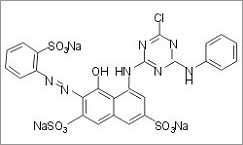Reactive dyes or fiber reactive dyes are basically a
class of highly coloured organic substances. Reactive dyes uses a
chromophore that contains a substituent that is quite capable of a
direct reaction with a fiber substrate. It is the covalent bonds Which
the reactive dyes form with the substrates that are responsible for
attaching the reactive dye to natural fibers. These bonds makes reactive
dyes among the most permanent of dyes. Cold reactive dyes, like Cibacron
F, Procion MX, and Drimarene K, are very easy to use as they can be
applied at room temperature. Reactive dyes are the best bet for dyeing
cotton and other cellulose fibers. They are primarily used for tinting
textiles.
Of late, fiber Reactive Dyes have also been developed for dyeing other
fibers but there is not much commercial success.
 Permanency
of the colour-
Permanency
of the colour- fiber Reactive Dyes can be easily said to be the
most permanent of all dye types. This is because of an unique quality,
unlike other dyes, it can actually form a covalent bond with the
Substrate (cellulose or protein molecule). After the formation of the
bond, there is only one molecule, as the molecule of the is now part of
the cellulose fiber molecule.
 Easy
washing-
Easy
washing- The fibers that are dyed with reactive dyes can be safely
dyed even with white garments without the danger of colouring it.
 Chemical
Binding-
Chemical
Binding- The chemical bonds as explained above significantly
improves the product's colour stability and washability. Thus, no doubt
reactive dying of cotton is presently the most popular textile dying
process in the world.
There are mainly three types of reactive dyes. They
are:
 Vinylsulphone
Dye (VS)-
Vinylsulphone
Dye (VS)- Vinylsulphone Dyes are moderately reactive. The dyeing
temperature is generally 600C and pH is 11.5 that gets applied by
utilising a mixture of soda ash and caustic soda. These dyes show
excellent fixation properties under proper alkaline condition. A typical
example is the Remazol Black B (CI Reactive Black 5)
 Monochlorotriazine
Dye (MCT)-
Monochlorotriazine
Dye (MCT)- Normally these dyes are less reactive than vinylsulphone
dyes. Reaction can take place in more energetic reaction conditions.
That is typically 800C and pH value of 10.5, are essential for a proper
fixation on cellulosic fibers. A typical monochlorotriazine dye is shown
here.

(Monochloro-s-triazine dye (Procion Red H-3B, C.I. Reactive Red 3)
 Bi-functional
Dye-
Bi-functional
Dye- A Bi-functional dye is a form of reactive dye that shows more
than one type of reactive group in the molecule. These reactive dyes are
designed in such a manner to have the capacity to react with the fiber
in more than a single way.

